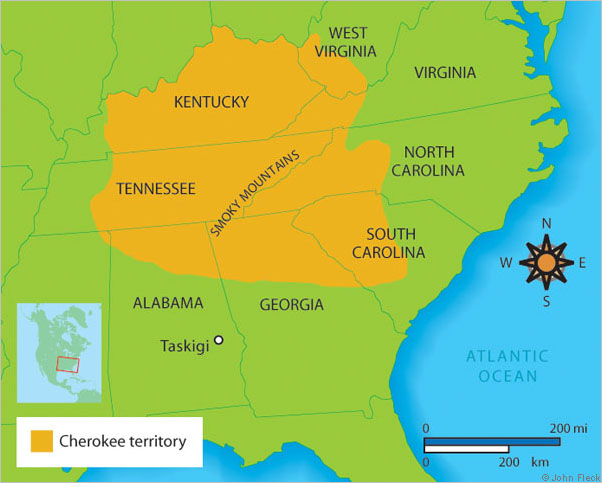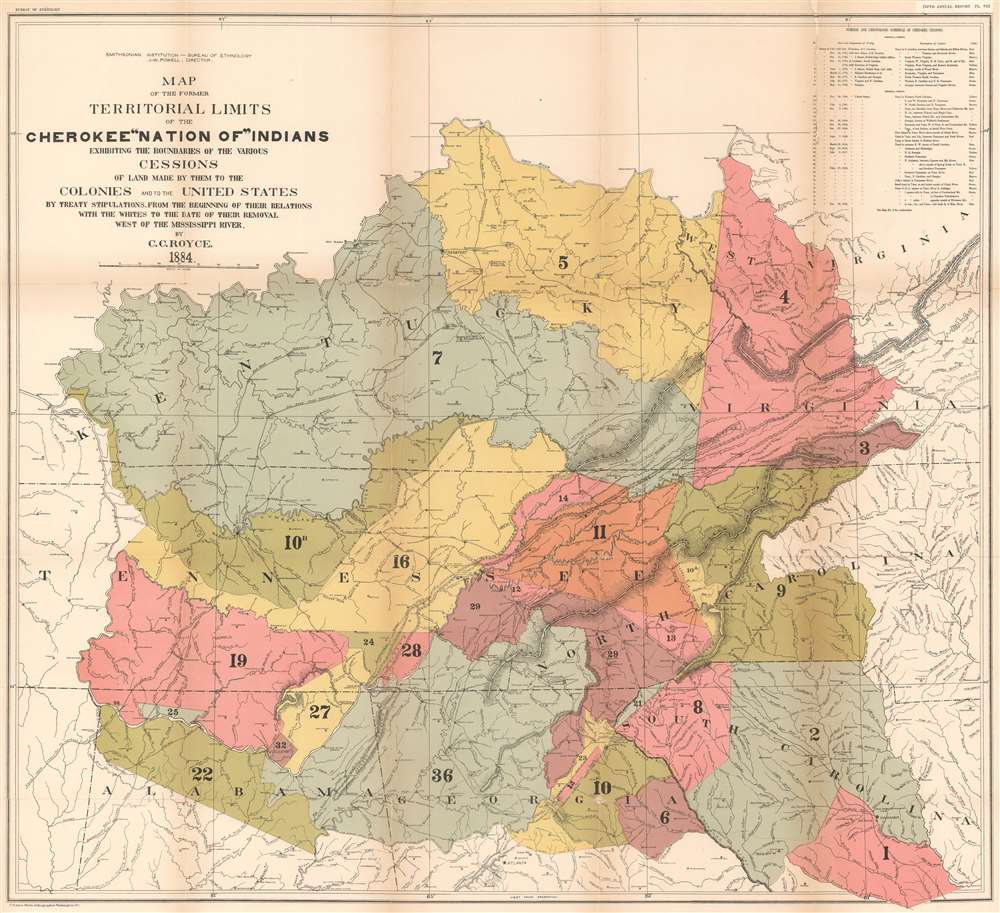The Tree That Marked a Nation: Unraveling the Mystery of the Cherokee Reservation Boundary Tree
The Tree That Marked a Nation: Unraveling the Mystery of the Cherokee Reservation Boundary Tree

The Cherokee Nation, a proud and resilient people, has a rich history woven into the very fabric of the southeastern United States. From their ancestral lands in the Appalachian Mountains to their forced relocation to present-day Oklahoma, their story is one of both triumph and tragedy. And at the heart of this narrative lies a single, remarkable tree – the Cherokee Reservation Boundary Tree. This seemingly ordinary oak, standing silent and stoic, played a pivotal role in shaping the fate of the Cherokee people, serving as a physical marker of their land and a symbol of their enduring spirit.
A Tree with a Story to Tell
Related Articles: The Tree That Marked a Nation: Unraveling the Mystery of the Cherokee Reservation Boundary Tree
- Unveiling the Largest Indian Tribe in Michigan: Discoveries and Insights Await
- Discover the Native American Tribe of Laredo, Texas: Unraveling Ancient Histories
- Unveiling Arizona's Indigenous Heritage: Discover the Enchanting Indian Reservations
- Uncover a Hidden Gem: Explore Native American Tribes of New York
- Discover the Enchanting Flathead Indian Reservation: Unearth Hidden Gems and Cultural Treasures
The Cherokee Reservation Boundary Tree, a massive oak estimated to be over 300 years old, stands tall in the heart of what was once the Cherokee Nation’s ancestral lands in present-day North Carolina. This tree, with its gnarled branches and deeply furrowed bark, has witnessed centuries of history unfold around it. Its roots, reaching deep into the earth, anchor it to a past marked by both prosperity and hardship.
The tree’s significance stems from its role as a landmark in the 1819 Treaty of New Echota, which established the boundaries of the Cherokee Nation in the Southeast. The treaty, signed under duress and marred by controversy, forced the Cherokee people to cede a significant portion of their ancestral lands to the United States government. The Cherokee Reservation Boundary Tree, designated as a crucial marker in the treaty, stood as a physical testament to the shrinking land that remained their home.
Curtis Wright and the Quest for Truth
The story of the Cherokee Reservation Boundary Tree gained renewed attention in the early 20th century thanks to the tireless efforts of Curtis Wright, a renowned historian and cartographer. Wright, driven by a deep respect for the Cherokee people and their history, embarked on a mission to uncover the truth behind the tree’s significance. His research, fueled by a passion for historical accuracy, led him through dusty archives, crumbling maps, and forgotten diaries.
Wright’s meticulous research yielded invaluable insights into the Cherokee Reservation Boundary Tree’s history. He unearthed old maps and documents that pinpointed the tree’s precise location, confirming its role as a vital landmark in the 1819 Treaty of New Echota. His findings, meticulously documented and presented in his book, "The Cherokee Reservation Boundary Tree: A Historical and Cartographic Investigation," shed light on the tree’s importance and its enduring legacy.
Beyond the Treaty: A Symbol of Resilience
The Cherokee Reservation Boundary Tree, however, is more than just a physical marker of a historical treaty. It transcends its historical significance to become a powerful symbol of the Cherokee people’s resilience, their unwavering spirit, and their enduring connection to their ancestral lands.
Despite the hardships they faced, the Cherokee people refused to be broken. They clung to their traditions, their language, and their identity. The Cherokee Reservation Boundary Tree, a silent witness to their struggles, stood as a testament to their strength and their unwavering determination. Its presence served as a reminder of their deep connection to the land, a connection that could not be severed by treaties or forced relocations.

The Tree Today: A Legacy of Hope
Today, the Cherokee Reservation Boundary Tree stands as a poignant reminder of the Cherokee Nation’s history and its enduring legacy. It is a place of pilgrimage for Cherokee people, a site where they can connect with their ancestors and pay homage to their heritage. The tree, with its gnarled branches reaching towards the sky, is a symbol of hope, a reminder that even in the face of adversity, the spirit of the Cherokee people remains strong.
The tree’s significance is not lost on the wider world. It has become a symbol of cultural preservation and historical awareness, a testament to the importance of understanding and honoring the stories of indigenous peoples. It serves as a reminder that the past is not just a collection of dates and events, but a living tapestry woven with the stories, struggles, and triumphs of those who came before us.
Beyond the Boundary: The Enduring Legacy
The Cherokee Reservation Boundary Tree’s story is not just a local tale, but a universal one. It resonates with anyone who has ever felt the pull of their ancestral roots, the yearning for a connection to their past. It reminds us that even in the face of change, the spirit of a people can endure.

The tree, now a designated historical landmark, stands as a powerful symbol of the Cherokee Nation’s resilience, their cultural heritage, and their enduring spirit. Its story serves as a reminder that history is not just about dates and events, but about the people who lived and breathed those stories, who shaped the world around them.
FAQ
Q: Where is the Cherokee Reservation Boundary Tree located?
A: The Cherokee Reservation Boundary Tree is located in present-day North Carolina, within the ancestral lands of the Cherokee Nation. Its exact location is a closely guarded secret, protected by the Cherokee people to ensure its preservation and respect.
Q: What is the significance of the tree?

A: The Cherokee Reservation Boundary Tree holds immense significance for the Cherokee Nation. It served as a crucial landmark in the 1819 Treaty of New Echota, which established the boundaries of the Cherokee Nation in the Southeast. The tree stands as a symbol of the Cherokee people’s resilience, their enduring spirit, and their deep connection to their ancestral lands.
Q: How can I learn more about the Cherokee Reservation Boundary Tree?
A: You can learn more about the Cherokee Reservation Boundary Tree by visiting the Cherokee Nation website or by contacting the Cherokee Nation Cultural Tourism office. You can also consult historical resources such as Curtis Wright’s book, "The Cherokee Reservation Boundary Tree: A Historical and Cartographic Investigation."
Q: Is the tree accessible to the public?
A: The Cherokee Reservation Boundary Tree is not accessible to the public. Its location is kept secret to ensure its protection and respect. However, the Cherokee Nation offers various cultural tours and programs that allow visitors to learn about the tree’s significance and the Cherokee Nation’s rich history.
Q: What is the importance of preserving the tree?
A: Preserving the Cherokee Reservation Boundary Tree is crucial for honoring the Cherokee Nation’s history and cultural heritage. The tree serves as a powerful reminder of the Cherokee people’s resilience, their enduring spirit, and their deep connection to their ancestral lands. Its preservation ensures that future generations will be able to learn from and be inspired by the Cherokee people’s story.
The Cherokee Reservation Boundary Tree stands as a silent testament to the resilience of the Cherokee people, their enduring spirit, and their deep connection to their ancestral lands. Its story is a powerful reminder that history is not just about dates and events, but about the people who lived and breathed those stories, who shaped the world around them. The tree, with its gnarled branches and deeply furrowed bark, continues to stand as a beacon of hope, a symbol of cultural preservation, and a testament to the enduring legacy of the Cherokee Nation.

Closure
Thus, we hope this article has provided valuable insights into The Tree That Marked a Nation: Unraveling the Mystery of the Cherokee Reservation Boundary Tree. We thank you for taking the time to read this article. See you in our next article!

